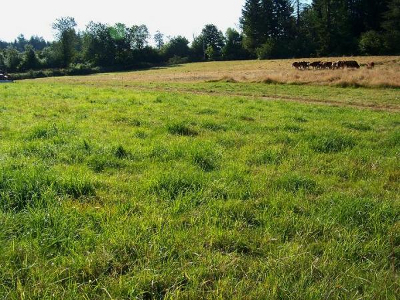
Coping with uneven pasture growth

This spring, the grass
in our chicken pastures was growing faster than the flock could eat
it. As a result, I left the chickens in each paddock a long time
to eat all that lush greenery, and by the time the girls got done with
all three paddocks, the earliest grazed paddock had gone to seed.
That depressed our summer growth extraordinarily, resulting in
over-grazed pastures all through the summer and fall, despite the fact
that (on paper) our pasture sizes seemed more than adequate to handle
the chickens living there.
This problem is very
common in improperly managed, rotational grazing settings. Bill
Murphy suggests three ways to deal with lush spring grazing:
Graze more animals in the spring. We got a late start with our broilers this year, but if we'd had a bunch of hungry young beaks to fill when the pasture was growing like gang-busters, we could have used up the excess pasture that way.
Mow behind animals. If you simply let your animals graze the lushest part of the pasture and rotate them at six days despite lots of plant matter being left, you can come in behind the animals and mow. This is the most wasteful and labor intensive, but with a bagging mower you could be collecting those high nitrogen clippings for the garden.
 Assuming we get the spring
overflow figured out, what do we do about the summer and fall
slowdown? The solution is to have more paddocks. With our
recovery period estimated to be 44 days in October and the maximum
occupation period being 6 days, we'd need 9 paddocks to keep from
grazing each area too soon. Although that sounds tricky, I
suspect that we could subdivide our existing pastures into much smaller
sections using temporary fencing, perhaps using pathways created by a
hoop of remesh to lead the chickens to each area at the proper time.
Assuming we get the spring
overflow figured out, what do we do about the summer and fall
slowdown? The solution is to have more paddocks. With our
recovery period estimated to be 44 days in October and the maximum
occupation period being 6 days, we'd need 9 paddocks to keep from
grazing each area too soon. Although that sounds tricky, I
suspect that we could subdivide our existing pastures into much smaller
sections using temporary fencing, perhaps using pathways created by a
hoop of remesh to lead the chickens to each area at the proper time.
Of course winter is
another matter entirely. Bill Murphy recommends stockpiling
summer growth to feed your livestock in winter, but non-ruminants won't
get much out of dried grass. We'll continue to experiment with annual
grains, and will
have to get creative if the pastures look bare in midwinter.
| This post is part of our Greener Pastures on Your Side of the Fence
lunchtime series.
Read all of the entries: |
Want more in-depth information? Browse through our books.
Or explore more posts by date or by subject.
About us: Anna Hess and Mark Hamilton spent over a decade living self-sufficiently in the mountains of Virginia before moving north to start over from scratch in the foothills of Ohio. They've experimented with permaculture, no-till gardening, trailersteading, home-based microbusinesses and much more, writing about their adventures in both blogs and books.
Want to be notified when new comments are posted on this page? Click on the RSS button after you add a comment to subscribe to the comment feed, or simply check the box beside "email replies to me" while writing your comment.

There is an amazing board game called Agricola that simulates managing a farm. It is a top-rated game for complexity, actually...and I could never understand why "building paddocks" was something a player could invest resources in doing...now I have a wee insight into the whole pasture management viz a viz choice and number of livestock. Who needs TV when there is much to learn just to manage 50 acres? God, we city people waste our lives...
I adore Agricola --- it's my favorite board game. I'm always amazed at how many permaculture concepts they manage to work into a very playable game.
Of course, the way I homestead seeps through into the way I play the game, so you can often beat me by understanding my Achilles heel --- I don't believe in big houses, etc. It does help me get big livestock dreams out of my system without having to cut down trees here on the real farm.